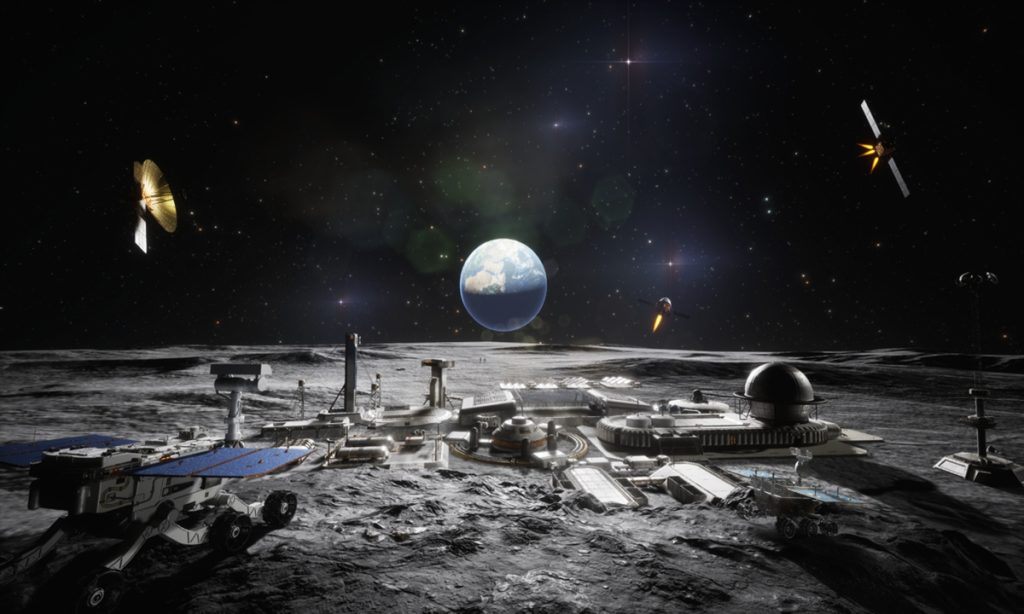Prototypes of key lunar devices supporting long-term research facilities on the moon make new progress: developer

The Global Times learned Tuesday from the Deep Space Exploration Lab (DSEL) that prototypes of the in-situ lunar soil 3D printing system and the lunar soil water ice thermal extraction system, which are key devices to support the country's future long-term research facilities on the surface of moon, have made new progress.
Dubbed the "lunar soil brick-maker," the in-situ lunar soil 3D printing system works by using concentrated solar energy to melt lunar soil at high temperatures and form bricks, Yang Honglun, a member of the development team with the DSEL, told the Global Times.
Specifically, a parabolic reflector of the system concentrates sunlight, which is then transmitted via fiber-optic bundles to generate solar energy about 3,000 times stronger. This intense heat raises the temperature of lunar soil above 1,300 C, allowing it to melt and form bricks, according to the lab.
Such 3D printing technology enables in-situ use of lunar resources and energy, eliminating the need to transport raw materials from Earth. Using only lunar soil and solar energy, it produces bricks with high strength and excellent thermal insulation properties—suitable for building roads, equipment platforms, and research station structures on the Moon. In essence, it makes it possible to use lunar soil to construct infrastructure on moon.
Yang disclosed that at the early stages of development, the core challenge was how to achieve reliable solar energy concentration and lunar soil forming under the Moon's extreme environmental conditions.
To address this, the team systematically evaluated multiple technological approaches. "For instance, in terms of solar concentration, we evaluated Fresnel lenses, thin-film lenses, and reflective concentrators," he said.
For lunar soil forming, the team considered powder sintering, high-temperature melting, and binder-based solidification. After a series of validation experiments, the team ultimately selected the "reflective concentration - fiber-optic energy transmission plus powder bed fusion" approach. This enabled us to overcome the full chain of challenges from energy capture and transmission to printing and shaping, he said.
According to the lab, the prototype has validated the lunar soil forming and manufacturing technology, showing it can meet the demands of large-scale construction of lunar infrastructure such as transportation roads, equipment platforms, and buildings. This provides essential support for broader, sustained lunar exploration and resource development efforts.
The prototype also verified key technologies such as lunar energy capture, material extraction, and conversion, laying a solid technical foundation for future deep space resource utilization and the construction of lunar energy systems, the lab revealed.
In addition to the in-situ lunar soil 3D printing system, the DSEL is also carrying out comprehensive technological research focused on the development and utilization of extraterrestrial resources and has already achieved several major breakthroughs, including the development of China's first multi-needle lunar soil water ice thermal extraction system, Global Times has learned during a tour of the lab.
The lunar polar regions are believed to contain abundant water ice resources. This ice is not only a vital source of life support for future international lunar research stations - providing drinking water and oxygen - but can also be electrolyzed to produce hydrogen and oxygen fuel, providing energy for deep space exploration missions. This would greatly reduce the cost and risk of transporting supplies from Earth.
However, the lunar surface is an extreme environment, characterized by high vacuum and extremely low temperatures, vastly different from Earth. As such, extracting usable water from lunar soil poses a major technical challenge for the future.
To tackle this, DSEL, together with Harbin Institute of Technology and other institutions, developed a device capable of extracting water from lunar soil.
The system can overcome key challenges such as the difficulty of excavating high-strength ice-bearing lunar soil, collecting water vapor in a vacuum, and achieving efficient water ice extraction, according to DSEL.
The system uses multiple slender helical drill needles to bore directly into simulated ice-rich lunar soil, where heat generates water vapor. The vapor is directed through flow channels into a low-temperature condenser, where it is solidified into ice for collection, the lab explained.
The system's water ice extraction efficiency and other key performance indicators have reached internationally advanced levels, the lab said.